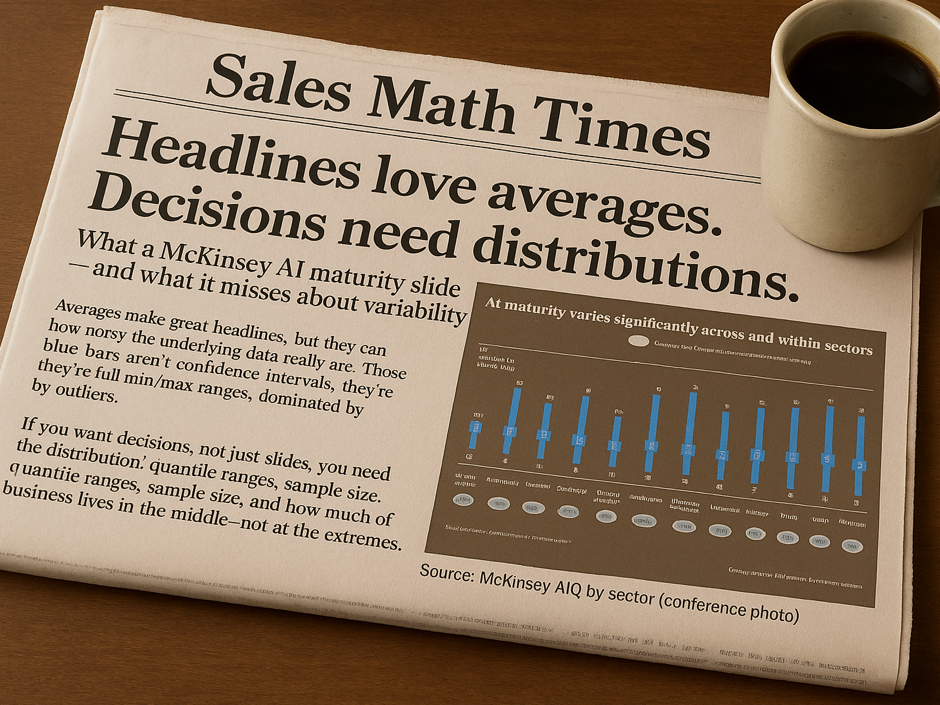Stop worrying about conversion rates, use this instead
- Bill Kantor

- Nov 3, 2022
- 4 min read
Updated: Oct 6
We hear the term “conversion rate” a lot, usually in the context of “this is a KPI we need to watch and improve.” And a lot of energy goes into computing this metric, at the expense of what businesses really need.
In his book “The Tyranny of Metrics” Jerry Muller points out that:
There are things that are worth measuring. But what can be measured is not always what is worth measuring; what gets measured may have no relationship to what we really want to know.
And “conversion rate” is a prime example. What businesses really care about is the win rate from each stage. But they measure stage-to-stage conversion rates—perhaps because long sales cycles make win rates difficult to compute and because they want an early indicator of what's happening. What’s wrong with conversion rates?
Is there an objective criterion of goodness? Is a high conversion rate from stage 1 to 2 good? Not clear. A high rate may mean you are wasting resources, passing too many opportunities to stage 2. At the stage before “closed won” (where the conversion rate is the win rate), higher figures are better. But where in your sales process does it change from low to high rates being good?
How can you use conversion rates? People often multiply the chain of stage-to-stage conversion rates to understand overall win rate, and to build forecasts. This is fraught with problems: insufficient data at some stages, opportunities skip stages, and it’s unclear over what period that win rate would be valid.
Are you computing it properly? Almost universally, businesses calculate conversion rates by excluding opportunities that have been in a stage for a very short (or long) time. Conversion rates are a function of time after entering a stage, and small changes in an arbitrary cutoff for exclusion can produce large changes in the metric. These simplifications lead to a distorted view of reality.
Muller goes on to say:
The things that get measured may draw effort away from the things we really care about. And measurement may provide us with distorted knowledge—knowledge that seems solid but is actually deceptive.
And that resonates. Stage-to-stage conversion rate is an arbitrarily defined metric that produces an unrealistic perspective. What’s the point?
What you really want is the proportion [of opportunities] that go on to win from each stage—the win rate. To do this properly requires incorporating all opportunities (independent of their age), adjusting for age differences, and computing win rates as a function of time since entering the stage. Funnelcast does this for you as shown below. (For a description of how to compute win rates as a function of time, see our blog post. Post includes detailed instructions and an Excel workbook example.)

Each line represents the cumulative win rate as a function of time. For example, 100 days after entering stage 4, 75% of such opportunities are closed won. Shaded areas are 95% confidence intervals on that measurement.
This chart tells us a lot about the sales process. Stages 1 and 2 are undifferentiated. Advancing from stage 1 to 2 is an illusion; it does not improve the likelihood of winning. It resets the clock for stage 1. Why is this? Maybe some stage 1 opportunities need an additional step before stage 3; or some opportunities start at stage 2 without ever touching stage 1. Diagnosing this requires more information about the sales process.
There is also a huge gap between stages 3 and 4. We are reminded of this cartoon.

Maybe this business should be more explicit about what happens between stages 3 and 4.
We are only beginning to see the power of win rates—they can help diagnose sales process issues and optimize your sales process. Win rates can also be used to forecast short- and long-term sales, or to understand how many new opportunities you need to meet a plan.
See how to sell more. Try Funnelcast. |
Funnelcast also produces similar curves by stage for “advance rates”—a more precise definition of conversion rate, taking into account that opportunities often skip stages. Comparing the advance rate chart below to the win rate chart above highlights the limitations of conversion/advance rates. In the advance rate chart, the lack of progress of stage 2 over stage 1 is masked. The gap between stages 3 and 4 is less apparent and it’s hard to know if something should be done about it.
The advance rate chart is useful for understanding when an opportunity that is stuck in a stage is most likely to advance. For example, if an opportunity is in stage 4 for 100 days, it is highly unlikely to ever advance. Funnelcast uses a more nuanced version of this information as an early indicator to highlight the urgency to advance an opportunity—lest it succumb to the maxim that “time kills all deals.”

Admittedly, the win rate vs. conversion rate (advance rate) distinction is a subtle concept that takes some time to grasp. But unlike conversion rates, win rates are precisely defined, and usable for forecasting and sales process optimization.
Next time someone asks about your "conversion" rates, maybe you should show them these sample charts. Then ask them what they hope to get out of it and if what they really want is win rates. Either way, Funnelcast has you covered.
Want to see your win rates? Check out our blog on how to compute them using the time-to-event method. (Includes an Excel workbook with instructions. Just paste your data in and you'll see your win rate curves.)
Advance rates are a little more complicated though. Want to see what your win rates and advance rates look like? Check out Funnelcast Essentials for free.




Comments